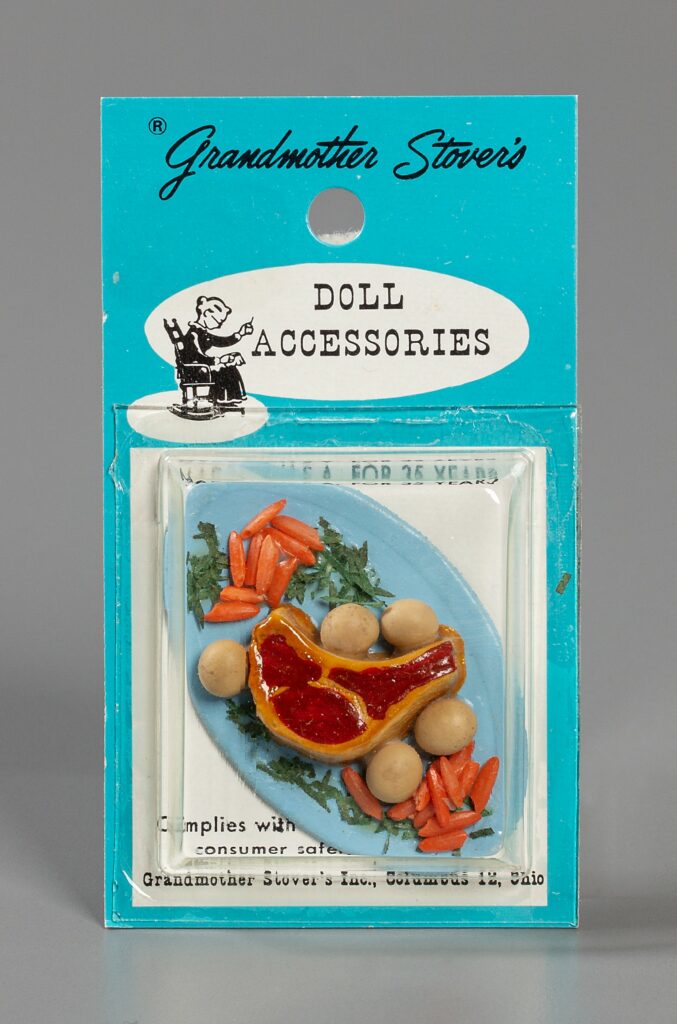The Strong recently acquired a collection of more than 350 Grandmother Stover’s miniatures, party favors, and trinkets. The objects in the collection date from the 1950s to the late 1970s and demonstrate American trends in play, gender roles, advertising, and gift giving occasions.
Advertising executive John Stover founded Grandmother Stover’s during World War II. The company’s origin story was frequently printed with slight variations, but the central element was that Stover became interested in miniatures when he attempted to furnish a dollhouse for his three daughters. Stover found that due to the war, many of the miniatures made in German cottage industries were no longer being imported to the United States. In addition, restrictions and material shortages made it difficult to produce toys. He wondered if artisans working in miniature could succeed in Ohio.
Stover named the company after his mother, Anna J. Stover. Their early miniatures were handmade, often with help from his mother and daughters, and featured realistic detailing. He soon ran advertisements for workers who began to make miniature towels, bedspreads, food, books, and other accessories. The miniatures were grouped thematically and packaged on cards. Stover sometimes included Dowst Brothers metal premiums, charms, and game tokens, and Eppy charms in the packages. Grandmother Stover’s miniatures were an immediate success.
In the late 1940s, Stover had the clever marketing plan to invite manufacturers of food and household supplies to pay for the reproduction of their labels in miniature form, which he then applied to accessories and sold under the Grandmother Stover’s brand. An early advertisement for a group of miniatures touted “for small girls or mini-mad grownups.” A package of miniature nursery items, for example, included a box of Sunshine Baby Arrowroot Biscuits, a type of biscuit invented in the late 1880s and intended for children’s delicate digestions. He also secured permissions to print miniature editions of newspapers and publications like The New York Times, Wall Street Journal, and Merriam-Webster Dictionary.
During the 1950s, the miniature business declined, but Stover, resourceful as always, reinvented his company with miniature items packaged as party favors. The company offered miniature umbrellas to garnish a cocktail, plastic babies for party games at baby showers, and tiny champagne bottles to decorate tables at a wedding, among many others. Adults who did not frequent toy stores now discovered Grandmother Stover’s products at gift and stationery stores.

The adult market proved fruitful, and Stover began making Fun Miniatures, which combined satire with card art and made for the perfect, inexpensive gag gift. Despite the scale of Fun Miniatures, the trinkets and artwork made a big statement. In the era of Mad Men, the Advertising Genius miniature kit included a dictionary, cocktail shaker, popular magazine titles, and a bottle of milk. The 1960s was a pivotal period of transformation in the advertising world. It included the formation of advertising conglomerates, the rise of television, and the advent of new technologies. In 1963, David Ogilvy’s Confessions of an Advertising Man became a bible for the advertising industry.
The New Father kit included the supplies needed for a late-night feeding and a box of cigars. The card featured an illustration of a disheveled man dressed in pajamas trying to feed a screaming baby. The set was sold in the mid-1960s, when the fatherhood movement communicated to men that although economic support was part of being a good father, it was also important to spend regular time with their children. Despite this discourse, stereotypical representations of fathers as clueless persisted. The For Those Who Do Very Little Housework set included a broom, a dustpan, a spider, a bottle of beer, and laundry soap. In the 1970s, studies indicated that the amount of time women spent doing housework showed no historical decline, despite more women securing paid employment outside of the home. A close look at the illustration on the header For Those Who Do Very Little Housework provides a social commentary—women were burned-out. Not all Fun Miniatures demonstrated progressive thinking and many people today would find those insensitive and offensive.

In the late 1970s, Stover retired to West Palm Beach and opened a shop. In a 1979 article, Ruth Drinkle noted, “In his store one can purchase anything for a doll house from a mouth-watering roast of beef, surrounded with potatoes and carrots on a blue platter ($1.50) to a bear rug ($8.00), a patch work quilt, or a Victorian arch and mantel.” I could spend many more hours looking at these packets and I have unanswered questions—such as was the miniature book How to Lose Weight first packaged with Mattel’s Slumber Party Barbie or with Grandmother Stover’s miniatures and what happened to the company’s records? The best resource I have found to date is the book Grandmother Stover’s Dollhouse Miniatures by Patty Cooper. And now, thanks to a generous donor, the museum’s online collections will also prove valuable to researchers and miniature enthusiasts.


